The Effect Of Corporate Social Responsibility
VerifiedAdded on 2022/09/18
|7
|1630
|18
AI Summary
Contribute Materials
Your contribution can guide someone’s learning journey. Share your
documents today.
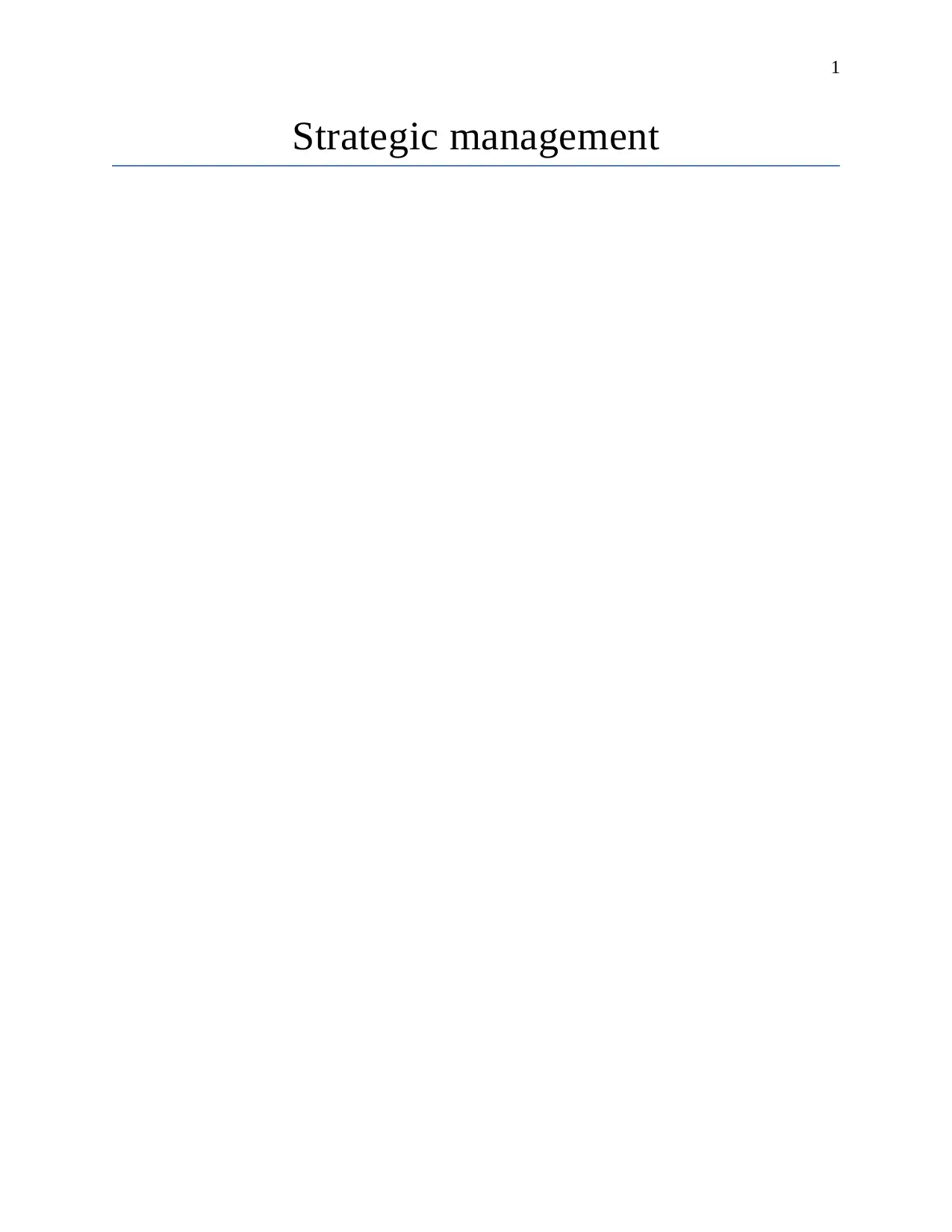
1
Strategic management
Strategic management
Secure Best Marks with AI Grader
Need help grading? Try our AI Grader for instant feedback on your assignments.
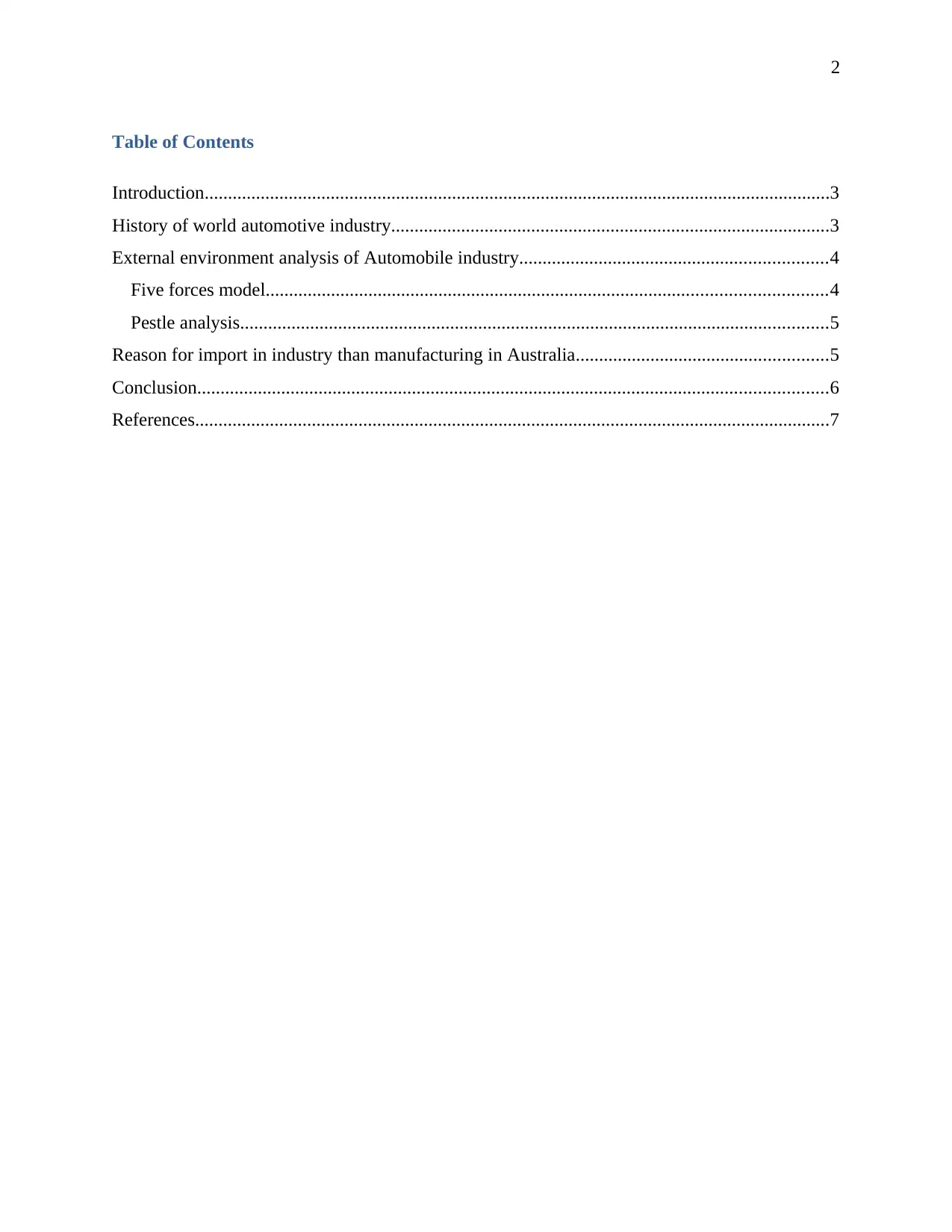
2
Table of Contents
Introduction......................................................................................................................................3
History of world automotive industry..............................................................................................3
External environment analysis of Automobile industry..................................................................4
Five forces model........................................................................................................................4
Pestle analysis..............................................................................................................................5
Reason for import in industry than manufacturing in Australia......................................................5
Conclusion.......................................................................................................................................6
References........................................................................................................................................7
Table of Contents
Introduction......................................................................................................................................3
History of world automotive industry..............................................................................................3
External environment analysis of Automobile industry..................................................................4
Five forces model........................................................................................................................4
Pestle analysis..............................................................................................................................5
Reason for import in industry than manufacturing in Australia......................................................5
Conclusion.......................................................................................................................................6
References........................................................................................................................................7

3
Introduction
In this assignment, the analysis of the automotive industry will be carried out. It will be covering
the history and background of the industry. In order to analyze the external environment of the
industry there will be pestle analysis which will be taken into consideration. In Australia most of
the manufacturers prefer to import and not to manufacture. The reasons for the same will be
identified in the assignment below.
History of the world automotive industry
The automotive industry developed in the 1860’s and ‘70s with the making of gasoline engine in
Germany and France. With the time there were various other countries which added to this
industry including America, Italy, and Britain. The mass production technique has been
introduced by henry ford and it gained the importance very early in the three companies’ namely
General Motors, Ford and Chrysler. After World War II there was great demand and it was
fulfilled by Japan and Europe (Miller, 2019). The first modern car was Mercedes which has been
presented in 1901 by Wilhelm Maybach. The engine of this car was of thirty-five horsepower
and it was for fourteen pounds per horsepower. In 1909 Daimler came as the most integrated
automobile factory in Europe and it employed around seventeen hundred workers so that they
can increase the production to thousand cars a year. There were new firms and they were
operating to provide consumer goods which are expensive. Automotive transportation was more
required by the United States in comparison to Europe. There was high per capita income and it
ensured more demand in the market by which the income distribution will be more equitable
(History, 2018). There was mass production which started by the Ford and was also adopted by
various American automobile manufacturers. The manufacturers count started dropping and
from 253 in 1908 it declined to 44 in 1929. Out of the complete output around 80% was provided
by the Chrysler, ford and general motors. With the development of time there was innovation
which was coming and it became difficult to meet with the requirements. The emphasis has been
made on the styling by general motors and under this models were changed on annual basis. The
market survey is carried to identify the demand for the new product and with time the industry
has attained high growth.
Introduction
In this assignment, the analysis of the automotive industry will be carried out. It will be covering
the history and background of the industry. In order to analyze the external environment of the
industry there will be pestle analysis which will be taken into consideration. In Australia most of
the manufacturers prefer to import and not to manufacture. The reasons for the same will be
identified in the assignment below.
History of the world automotive industry
The automotive industry developed in the 1860’s and ‘70s with the making of gasoline engine in
Germany and France. With the time there were various other countries which added to this
industry including America, Italy, and Britain. The mass production technique has been
introduced by henry ford and it gained the importance very early in the three companies’ namely
General Motors, Ford and Chrysler. After World War II there was great demand and it was
fulfilled by Japan and Europe (Miller, 2019). The first modern car was Mercedes which has been
presented in 1901 by Wilhelm Maybach. The engine of this car was of thirty-five horsepower
and it was for fourteen pounds per horsepower. In 1909 Daimler came as the most integrated
automobile factory in Europe and it employed around seventeen hundred workers so that they
can increase the production to thousand cars a year. There were new firms and they were
operating to provide consumer goods which are expensive. Automotive transportation was more
required by the United States in comparison to Europe. There was high per capita income and it
ensured more demand in the market by which the income distribution will be more equitable
(History, 2018). There was mass production which started by the Ford and was also adopted by
various American automobile manufacturers. The manufacturers count started dropping and
from 253 in 1908 it declined to 44 in 1929. Out of the complete output around 80% was provided
by the Chrysler, ford and general motors. With the development of time there was innovation
which was coming and it became difficult to meet with the requirements. The emphasis has been
made on the styling by general motors and under this models were changed on annual basis. The
market survey is carried to identify the demand for the new product and with time the industry
has attained high growth.
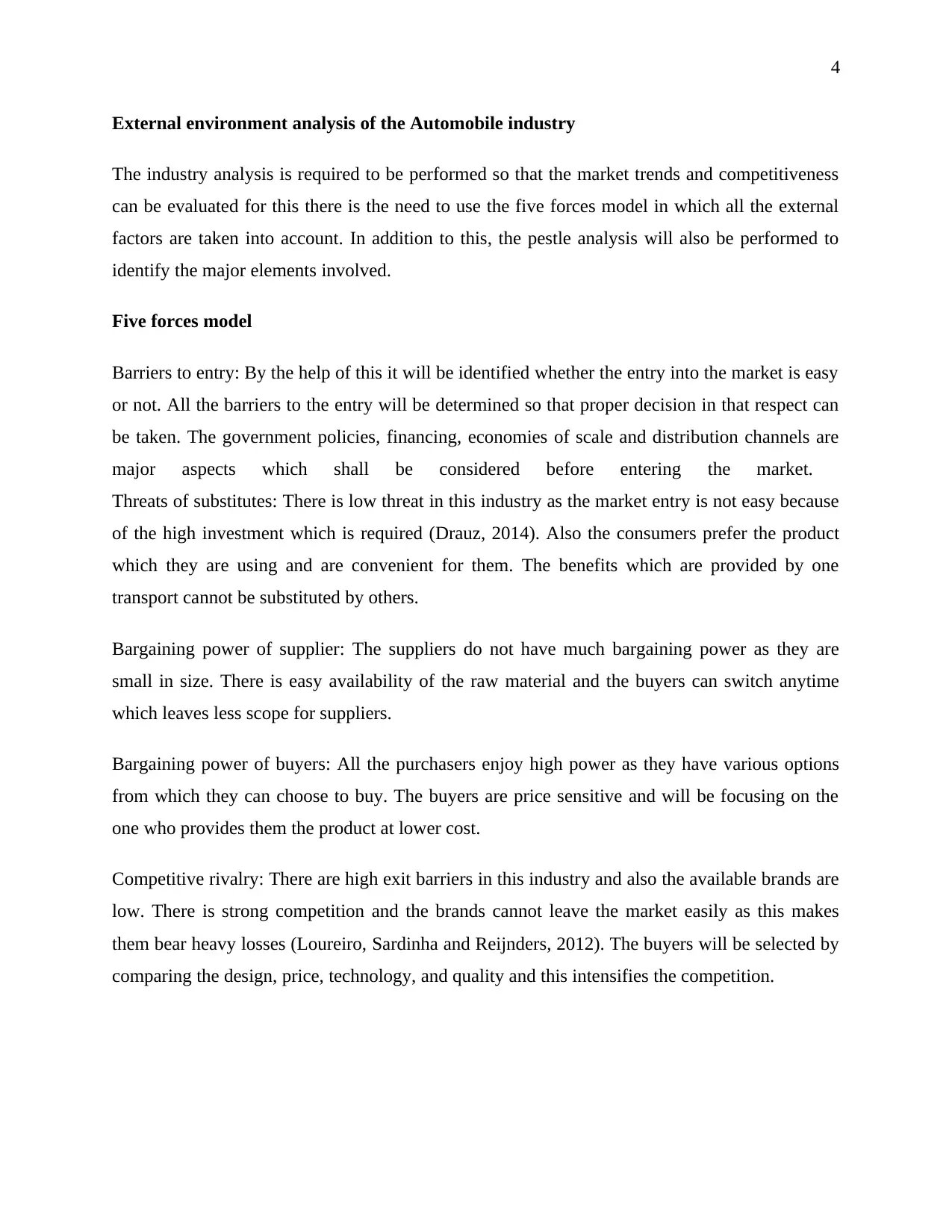
4
External environment analysis of the Automobile industry
The industry analysis is required to be performed so that the market trends and competitiveness
can be evaluated for this there is the need to use the five forces model in which all the external
factors are taken into account. In addition to this, the pestle analysis will also be performed to
identify the major elements involved.
Five forces model
Barriers to entry: By the help of this it will be identified whether the entry into the market is easy
or not. All the barriers to the entry will be determined so that proper decision in that respect can
be taken. The government policies, financing, economies of scale and distribution channels are
major aspects which shall be considered before entering the market.
Threats of substitutes: There is low threat in this industry as the market entry is not easy because
of the high investment which is required (Drauz, 2014). Also the consumers prefer the product
which they are using and are convenient for them. The benefits which are provided by one
transport cannot be substituted by others.
Bargaining power of supplier: The suppliers do not have much bargaining power as they are
small in size. There is easy availability of the raw material and the buyers can switch anytime
which leaves less scope for suppliers.
Bargaining power of buyers: All the purchasers enjoy high power as they have various options
from which they can choose to buy. The buyers are price sensitive and will be focusing on the
one who provides them the product at lower cost.
Competitive rivalry: There are high exit barriers in this industry and also the available brands are
low. There is strong competition and the brands cannot leave the market easily as this makes
them bear heavy losses (Loureiro, Sardinha and Reijnders, 2012). The buyers will be selected by
comparing the design, price, technology, and quality and this intensifies the competition.
External environment analysis of the Automobile industry
The industry analysis is required to be performed so that the market trends and competitiveness
can be evaluated for this there is the need to use the five forces model in which all the external
factors are taken into account. In addition to this, the pestle analysis will also be performed to
identify the major elements involved.
Five forces model
Barriers to entry: By the help of this it will be identified whether the entry into the market is easy
or not. All the barriers to the entry will be determined so that proper decision in that respect can
be taken. The government policies, financing, economies of scale and distribution channels are
major aspects which shall be considered before entering the market.
Threats of substitutes: There is low threat in this industry as the market entry is not easy because
of the high investment which is required (Drauz, 2014). Also the consumers prefer the product
which they are using and are convenient for them. The benefits which are provided by one
transport cannot be substituted by others.
Bargaining power of supplier: The suppliers do not have much bargaining power as they are
small in size. There is easy availability of the raw material and the buyers can switch anytime
which leaves less scope for suppliers.
Bargaining power of buyers: All the purchasers enjoy high power as they have various options
from which they can choose to buy. The buyers are price sensitive and will be focusing on the
one who provides them the product at lower cost.
Competitive rivalry: There are high exit barriers in this industry and also the available brands are
low. There is strong competition and the brands cannot leave the market easily as this makes
them bear heavy losses (Loureiro, Sardinha and Reijnders, 2012). The buyers will be selected by
comparing the design, price, technology, and quality and this intensifies the competition.
Secure Best Marks with AI Grader
Need help grading? Try our AI Grader for instant feedback on your assignments.
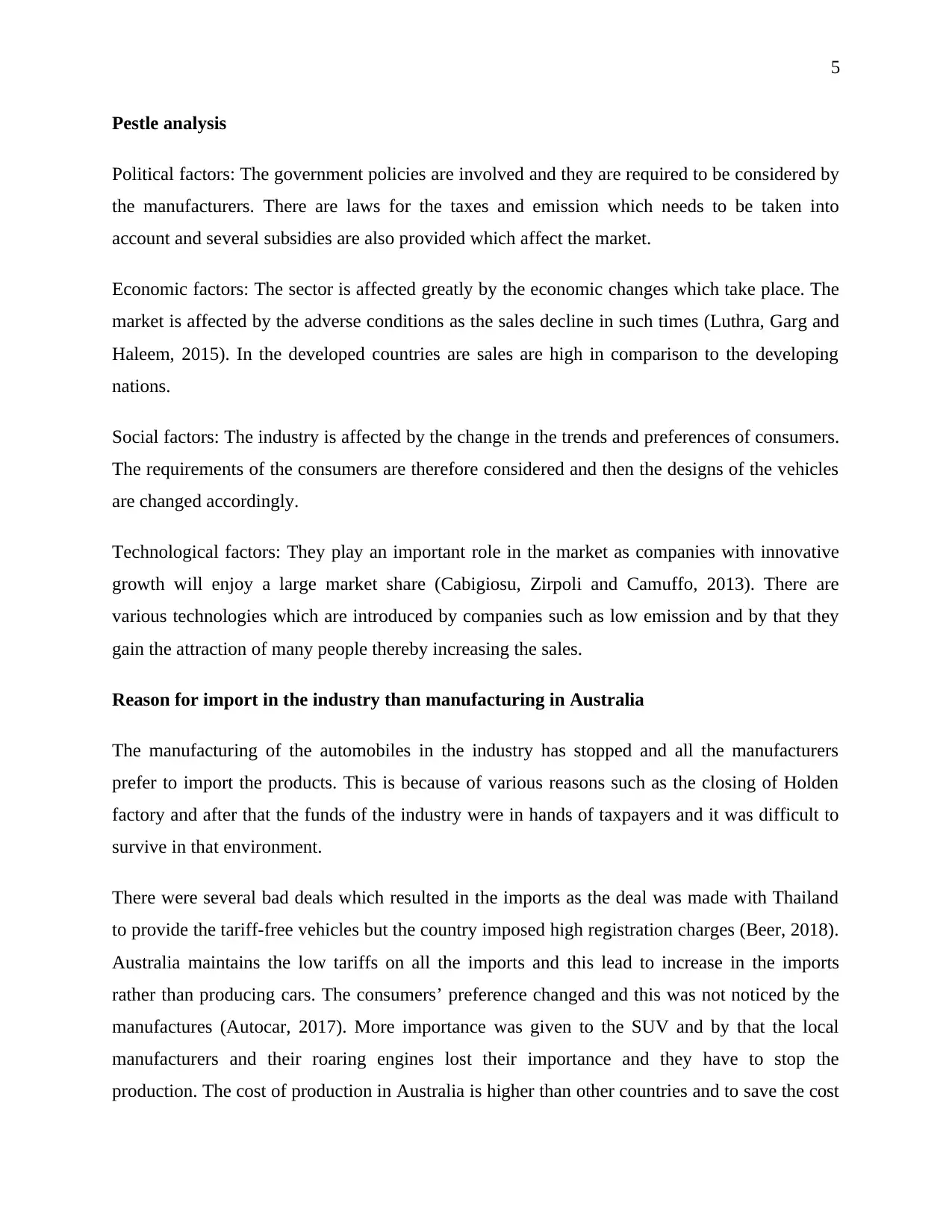
5
Pestle analysis
Political factors: The government policies are involved and they are required to be considered by
the manufacturers. There are laws for the taxes and emission which needs to be taken into
account and several subsidies are also provided which affect the market.
Economic factors: The sector is affected greatly by the economic changes which take place. The
market is affected by the adverse conditions as the sales decline in such times (Luthra, Garg and
Haleem, 2015). In the developed countries are sales are high in comparison to the developing
nations.
Social factors: The industry is affected by the change in the trends and preferences of consumers.
The requirements of the consumers are therefore considered and then the designs of the vehicles
are changed accordingly.
Technological factors: They play an important role in the market as companies with innovative
growth will enjoy a large market share (Cabigiosu, Zirpoli and Camuffo, 2013). There are
various technologies which are introduced by companies such as low emission and by that they
gain the attraction of many people thereby increasing the sales.
Reason for import in the industry than manufacturing in Australia
The manufacturing of the automobiles in the industry has stopped and all the manufacturers
prefer to import the products. This is because of various reasons such as the closing of Holden
factory and after that the funds of the industry were in hands of taxpayers and it was difficult to
survive in that environment.
There were several bad deals which resulted in the imports as the deal was made with Thailand
to provide the tariff-free vehicles but the country imposed high registration charges (Beer, 2018).
Australia maintains the low tariffs on all the imports and this lead to increase in the imports
rather than producing cars. The consumers’ preference changed and this was not noticed by the
manufactures (Autocar, 2017). More importance was given to the SUV and by that the local
manufacturers and their roaring engines lost their importance and they have to stop the
production. The cost of production in Australia is higher than other countries and to save the cost
Pestle analysis
Political factors: The government policies are involved and they are required to be considered by
the manufacturers. There are laws for the taxes and emission which needs to be taken into
account and several subsidies are also provided which affect the market.
Economic factors: The sector is affected greatly by the economic changes which take place. The
market is affected by the adverse conditions as the sales decline in such times (Luthra, Garg and
Haleem, 2015). In the developed countries are sales are high in comparison to the developing
nations.
Social factors: The industry is affected by the change in the trends and preferences of consumers.
The requirements of the consumers are therefore considered and then the designs of the vehicles
are changed accordingly.
Technological factors: They play an important role in the market as companies with innovative
growth will enjoy a large market share (Cabigiosu, Zirpoli and Camuffo, 2013). There are
various technologies which are introduced by companies such as low emission and by that they
gain the attraction of many people thereby increasing the sales.
Reason for import in the industry than manufacturing in Australia
The manufacturing of the automobiles in the industry has stopped and all the manufacturers
prefer to import the products. This is because of various reasons such as the closing of Holden
factory and after that the funds of the industry were in hands of taxpayers and it was difficult to
survive in that environment.
There were several bad deals which resulted in the imports as the deal was made with Thailand
to provide the tariff-free vehicles but the country imposed high registration charges (Beer, 2018).
Australia maintains the low tariffs on all the imports and this lead to increase in the imports
rather than producing cars. The consumers’ preference changed and this was not noticed by the
manufactures (Autocar, 2017). More importance was given to the SUV and by that the local
manufacturers and their roaring engines lost their importance and they have to stop the
production. The cost of production in Australia is higher than other countries and to save the cost
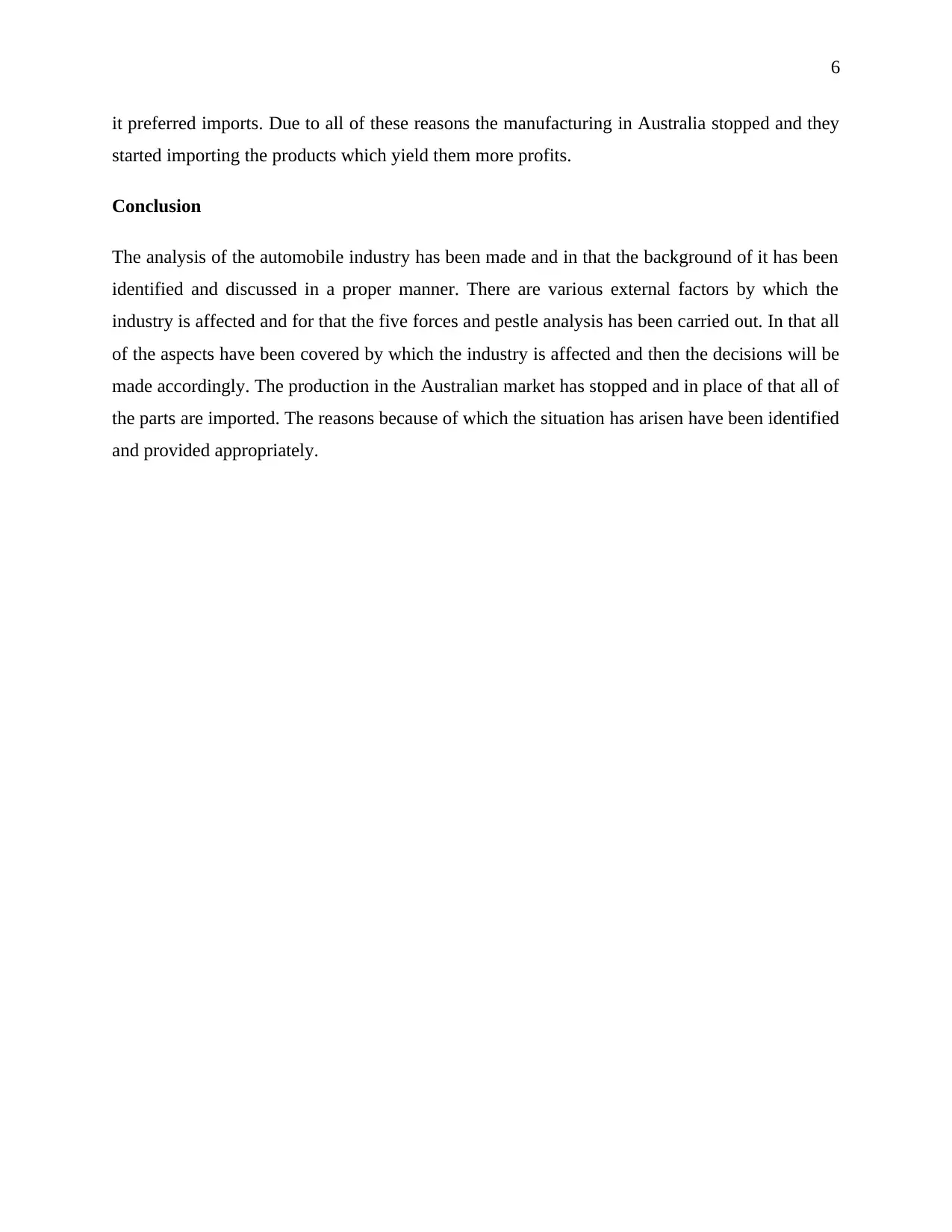
6
it preferred imports. Due to all of these reasons the manufacturing in Australia stopped and they
started importing the products which yield them more profits.
Conclusion
The analysis of the automobile industry has been made and in that the background of it has been
identified and discussed in a proper manner. There are various external factors by which the
industry is affected and for that the five forces and pestle analysis has been carried out. In that all
of the aspects have been covered by which the industry is affected and then the decisions will be
made accordingly. The production in the Australian market has stopped and in place of that all of
the parts are imported. The reasons because of which the situation has arisen have been identified
and provided appropriately.
it preferred imports. Due to all of these reasons the manufacturing in Australia stopped and they
started importing the products which yield them more profits.
Conclusion
The analysis of the automobile industry has been made and in that the background of it has been
identified and discussed in a proper manner. There are various external factors by which the
industry is affected and for that the five forces and pestle analysis has been carried out. In that all
of the aspects have been covered by which the industry is affected and then the decisions will be
made accordingly. The production in the Australian market has stopped and in place of that all of
the parts are imported. The reasons because of which the situation has arisen have been identified
and provided appropriately.
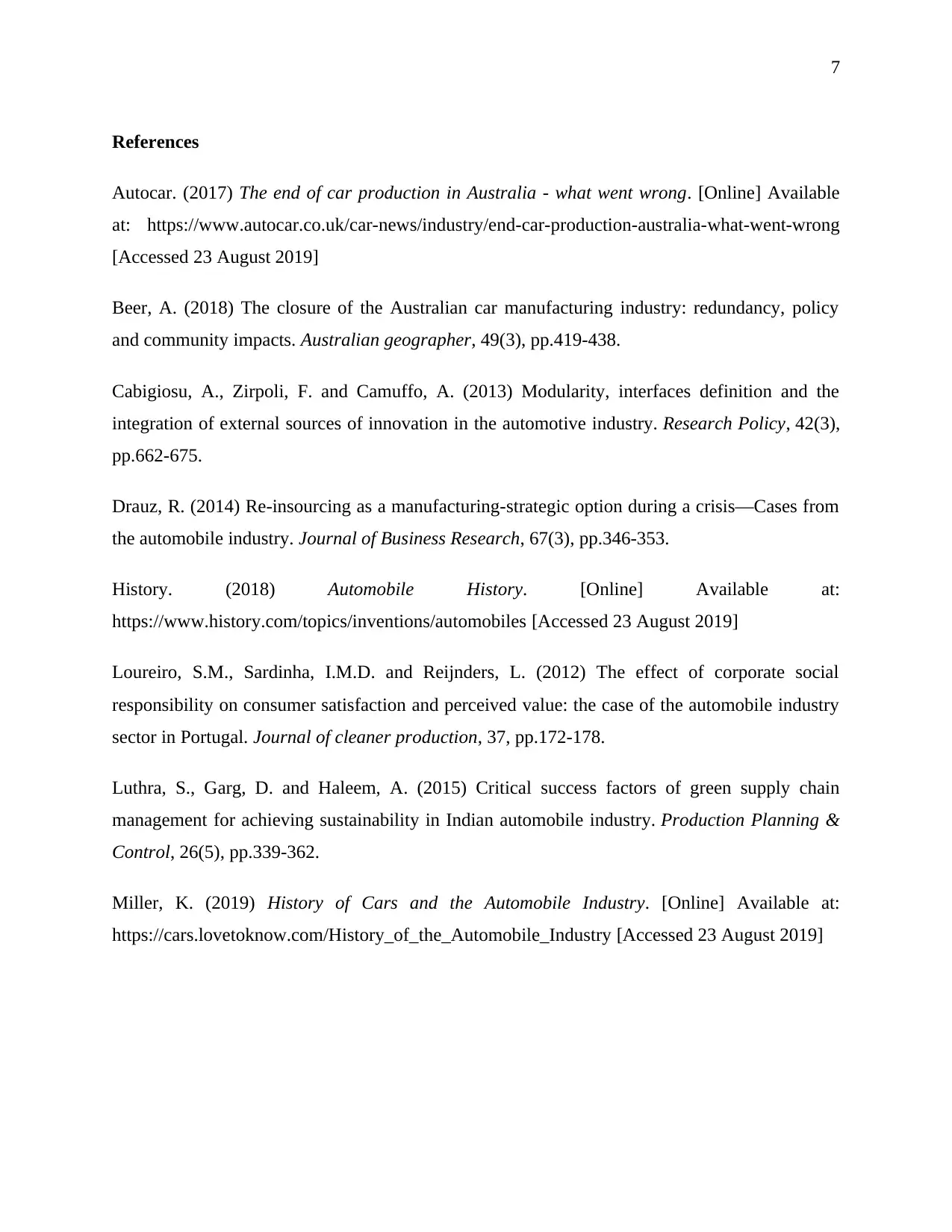
7
References
Autocar. (2017) The end of car production in Australia - what went wrong. [Online] Available
at: https://www.autocar.co.uk/car-news/industry/end-car-production-australia-what-went-wrong
[Accessed 23 August 2019]
Beer, A. (2018) The closure of the Australian car manufacturing industry: redundancy, policy
and community impacts. Australian geographer, 49(3), pp.419-438.
Cabigiosu, A., Zirpoli, F. and Camuffo, A. (2013) Modularity, interfaces definition and the
integration of external sources of innovation in the automotive industry. Research Policy, 42(3),
pp.662-675.
Drauz, R. (2014) Re-insourcing as a manufacturing-strategic option during a crisis—Cases from
the automobile industry. Journal of Business Research, 67(3), pp.346-353.
History. (2018) Automobile History. [Online] Available at:
https://www.history.com/topics/inventions/automobiles [Accessed 23 August 2019]
Loureiro, S.M., Sardinha, I.M.D. and Reijnders, L. (2012) The effect of corporate social
responsibility on consumer satisfaction and perceived value: the case of the automobile industry
sector in Portugal. Journal of cleaner production, 37, pp.172-178.
Luthra, S., Garg, D. and Haleem, A. (2015) Critical success factors of green supply chain
management for achieving sustainability in Indian automobile industry. Production Planning &
Control, 26(5), pp.339-362.
Miller, K. (2019) History of Cars and the Automobile Industry. [Online] Available at:
https://cars.lovetoknow.com/History_of_the_Automobile_Industry [Accessed 23 August 2019]
References
Autocar. (2017) The end of car production in Australia - what went wrong. [Online] Available
at: https://www.autocar.co.uk/car-news/industry/end-car-production-australia-what-went-wrong
[Accessed 23 August 2019]
Beer, A. (2018) The closure of the Australian car manufacturing industry: redundancy, policy
and community impacts. Australian geographer, 49(3), pp.419-438.
Cabigiosu, A., Zirpoli, F. and Camuffo, A. (2013) Modularity, interfaces definition and the
integration of external sources of innovation in the automotive industry. Research Policy, 42(3),
pp.662-675.
Drauz, R. (2014) Re-insourcing as a manufacturing-strategic option during a crisis—Cases from
the automobile industry. Journal of Business Research, 67(3), pp.346-353.
History. (2018) Automobile History. [Online] Available at:
https://www.history.com/topics/inventions/automobiles [Accessed 23 August 2019]
Loureiro, S.M., Sardinha, I.M.D. and Reijnders, L. (2012) The effect of corporate social
responsibility on consumer satisfaction and perceived value: the case of the automobile industry
sector in Portugal. Journal of cleaner production, 37, pp.172-178.
Luthra, S., Garg, D. and Haleem, A. (2015) Critical success factors of green supply chain
management for achieving sustainability in Indian automobile industry. Production Planning &
Control, 26(5), pp.339-362.
Miller, K. (2019) History of Cars and the Automobile Industry. [Online] Available at:
https://cars.lovetoknow.com/History_of_the_Automobile_Industry [Accessed 23 August 2019]
1 out of 7
Related Documents
Your All-in-One AI-Powered Toolkit for Academic Success.
+13062052269
info@desklib.com
Available 24*7 on WhatsApp / Email
![[object Object]](/_next/static/media/star-bottom.7253800d.svg)
Unlock your academic potential
© 2024 | Zucol Services PVT LTD | All rights reserved.





